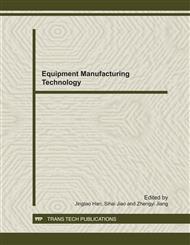[1]
Lorenzo Moreno, Carina Gonzalez, Ivan Castilla, Evelio Gonzalez, Jose Sigut. Applying a constructivist and collaborative methodological approach in engineering education [J], computer and education, 49: 891–915 (2005).
DOI: 10.1016/j.compedu.2005.12.004
Google Scholar
[2]
Oldroyd, J. B. and Gulati, R. 'A Learning Perspective on Intraorganizational Knowledge Spill-ins', Strategic Entrepreneurship Journal 4(4): 356–72 (2010).
DOI: 10.1002/sej.101
Google Scholar
[3]
Vanneste, B. S. and Puranam, P. 'Repeated Interactions and Contractual Detail: Identifying the Learning Effect', Organization Science 21(1): 186–201 (2010).
DOI: 10.1287/orsc.1080.0402
Google Scholar
[4]
Laurie P. Dringus, Timothy Ellis. Using data mining as a strategy for assessing asynchronous discussion forums [J], Computers & Education, 45: 141–160 (2005).
DOI: 10.1016/j.compedu.2004.05.003
Google Scholar
[5]
Steven Albert & Colin Thomasa. New Approach to Computer-aided Distance Learning: the 'Automated Tutor' [J]. Open Learning, Vol. 15, No.2: 141-150 (2000).
DOI: 10.1080/713688395
Google Scholar
[6]
Janet Macdonald, Erica Mcateer. New Approaches to Supporting Learners: strategies for blended learning in distance and campus based environments [J]. Journal of Educational Media, October, 28:129-146 (2003).
DOI: 10.1080/1358165032000165662
Google Scholar
[7]
Wei-yuan Zhang, Kirk Perris and Lesley Yeung. Online tutorial support in open and distance learning: learners' perceptions [J]. Journal of Educational Technology, 36 (5): 789–804 (2005)
DOI: 10.1111/j.1467-8535.2004.00492.x
Google Scholar
[8]
Karen Kear. Collaborative learning using asynchronous discussion systems in distance education[J]. The Open Learning, 19 (2):151-164 (2004).
DOI: 10.1080/0268051042000224752
Google Scholar
[9]
Anne Dobinson-Harrington. Personal tutor encounters: understanding the experience [J]. Nursing Standard, 20(50): 25-42 (2006)
DOI: 10.7748/ns.20.50.35.s50
Google Scholar
[10]
Ormond Simpson. Predicting learner success in open and distance learning [J], Open Learning, 21 (2): 125–138 (2006).
DOI: 10.1080/02680510600713110
Google Scholar


